Principles of Marketing: Vineyard Marketing and Expansion Plan
VerifiedAdded on 2023/01/10
|12
|3712
|29
Report
AI Summary
This report provides a comprehensive analysis of marketing principles applied to a vineyard's overseas expansion strategy. It begins with an introduction to marketing and its importance for business growth, followed by a detailed examination of the marketing planning process, including market research, target market selection, and the role of competition. The report then delves into the market environment, discussing PESTEL analysis to assess political, economic, social, technological, environmental, and legal factors, along with a micro-environment analysis using SWOT. Furthermore, the report explores the marketing mix (7Ps), segmentation, targeting, and positioning (STP) strategies, specifically focusing on the B2C target market and tourists seeking vineyard tours. The report aims to provide insights into developing a successful marketing plan for the vineyard's expansion. The report also provides a detailed understanding of market orientation and its role in customer satisfaction.
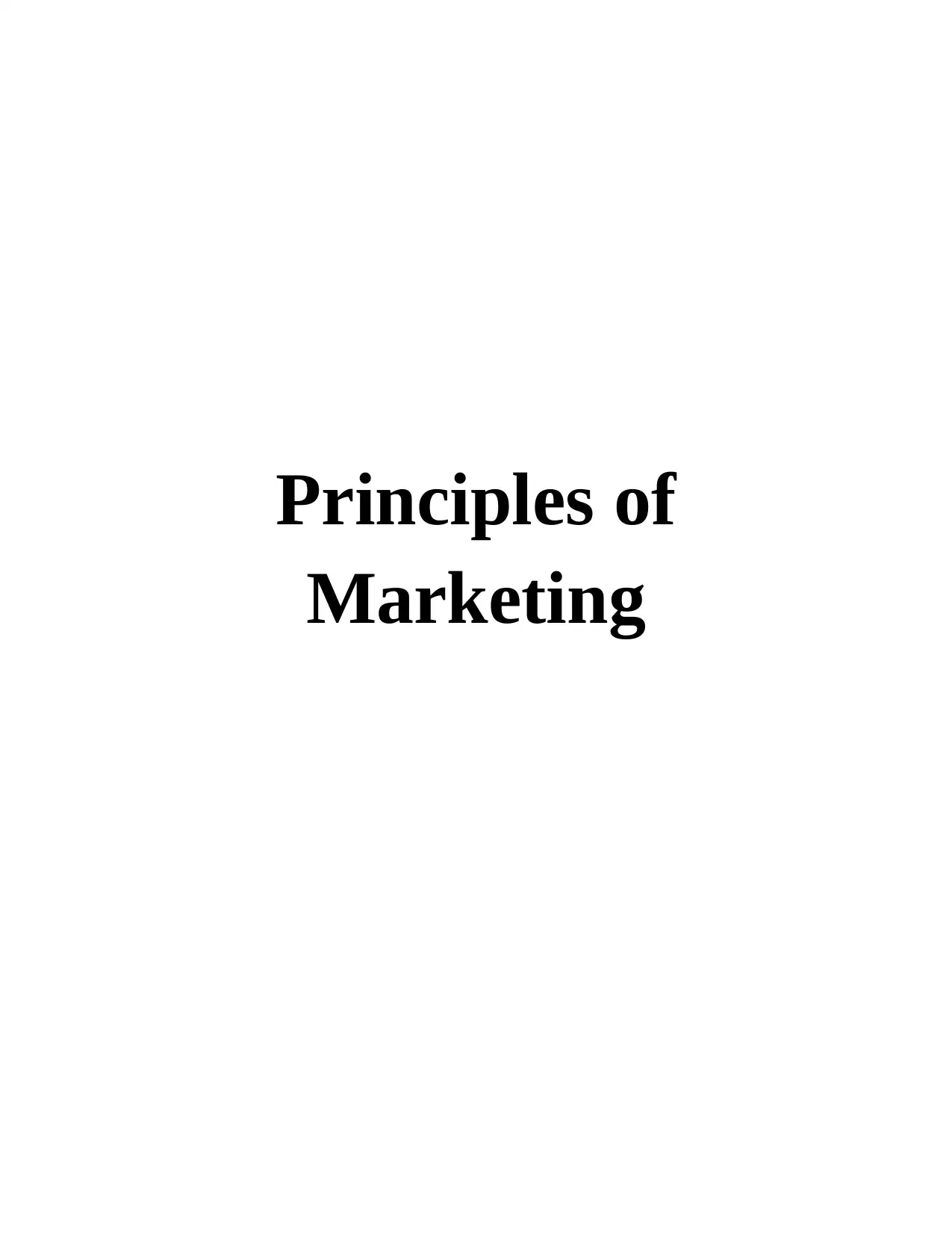
Principles of
Marketing
Marketing
Paraphrase This Document
Need a fresh take? Get an instant paraphrase of this document with our AI Paraphraser
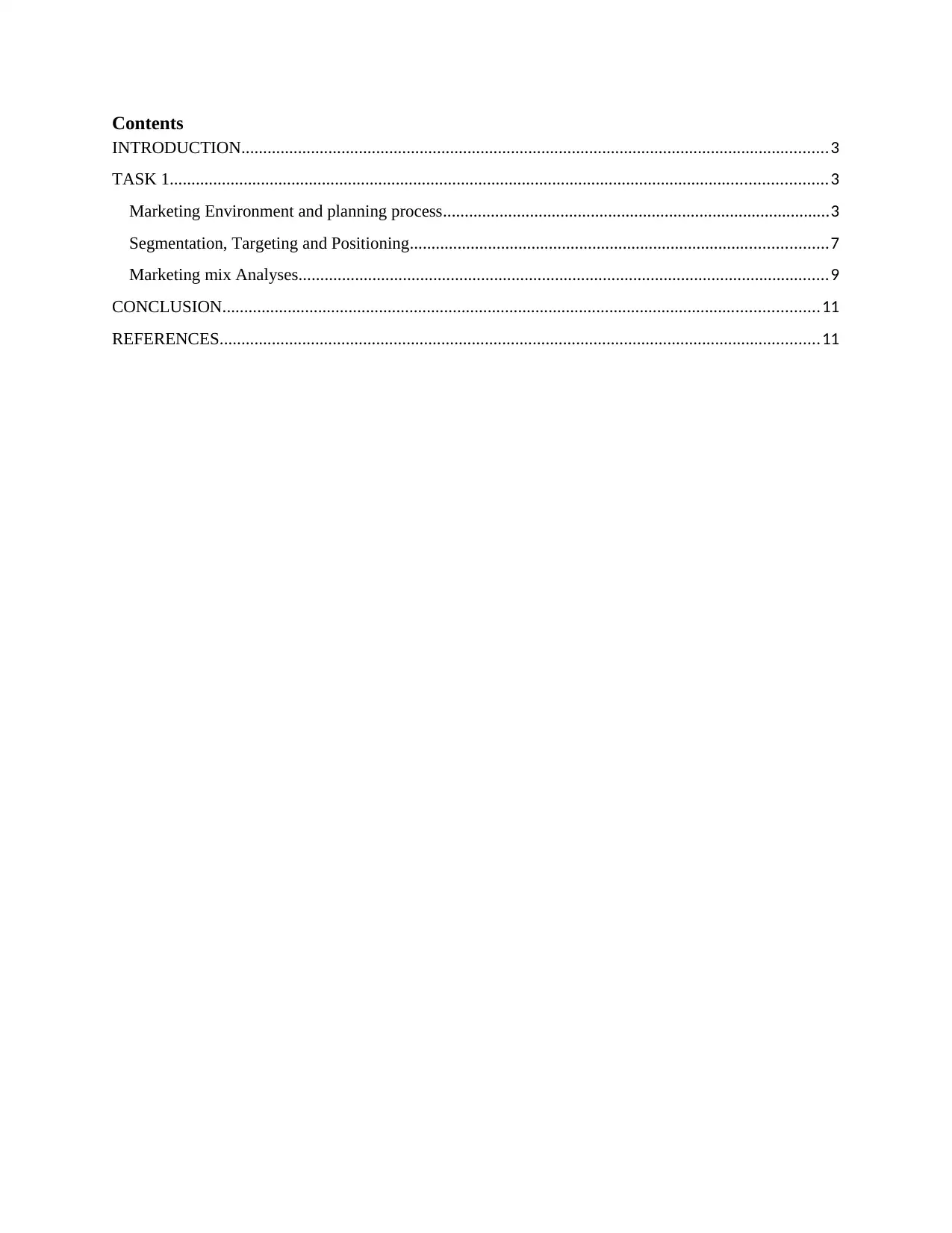
Contents
INTRODUCTION.......................................................................................................................................3
TASK 1.......................................................................................................................................................3
Marketing Environment and planning process.........................................................................................3
Segmentation, Targeting and Positioning................................................................................................7
Marketing mix Analyses..........................................................................................................................9
CONCLUSION.........................................................................................................................................11
REFERENCES..........................................................................................................................................11
INTRODUCTION.......................................................................................................................................3
TASK 1.......................................................................................................................................................3
Marketing Environment and planning process.........................................................................................3
Segmentation, Targeting and Positioning................................................................................................7
Marketing mix Analyses..........................................................................................................................9
CONCLUSION.........................................................................................................................................11
REFERENCES..........................................................................................................................................11
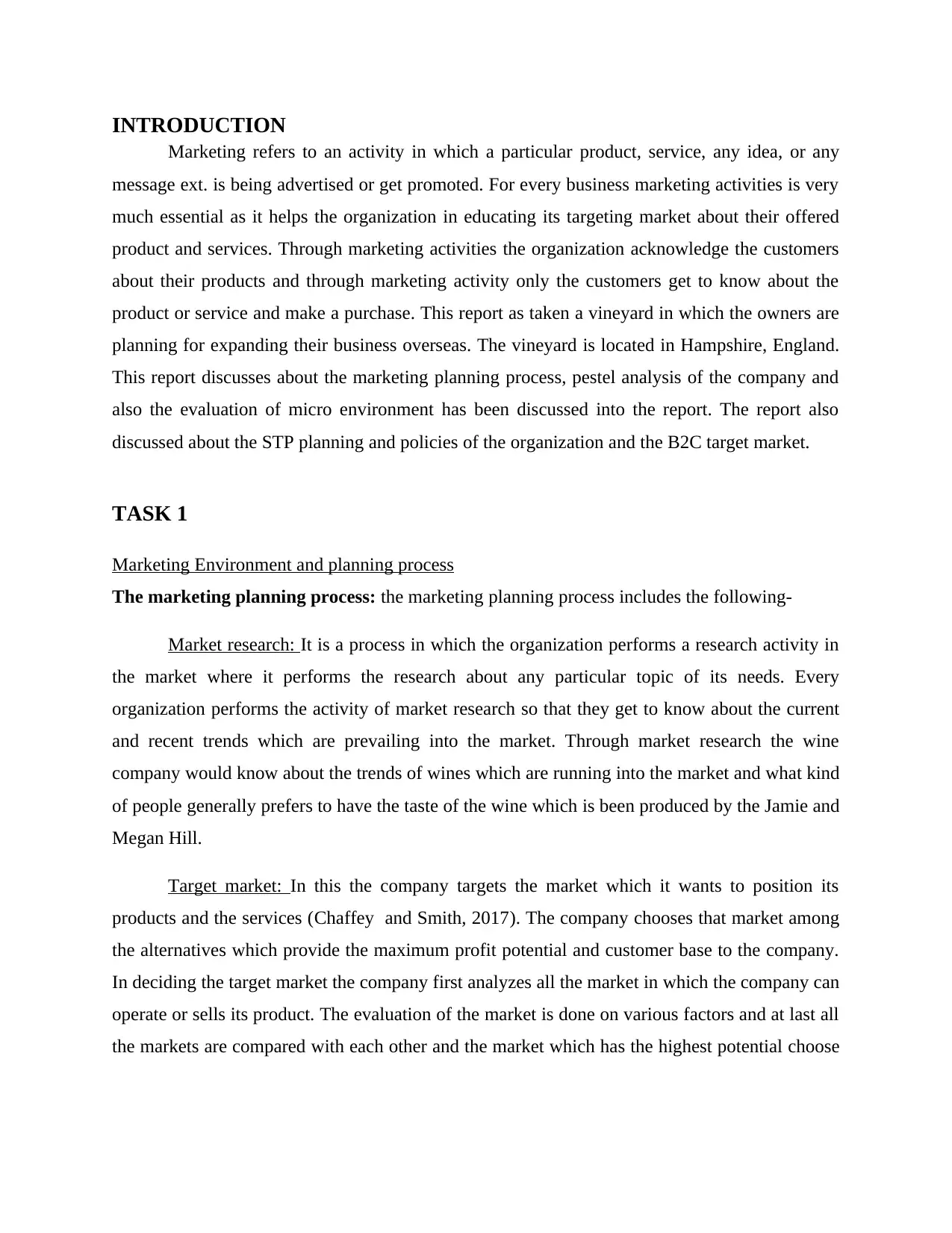
INTRODUCTION
Marketing refers to an activity in which a particular product, service, any idea, or any
message ext. is being advertised or get promoted. For every business marketing activities is very
much essential as it helps the organization in educating its targeting market about their offered
product and services. Through marketing activities the organization acknowledge the customers
about their products and through marketing activity only the customers get to know about the
product or service and make a purchase. This report as taken a vineyard in which the owners are
planning for expanding their business overseas. The vineyard is located in Hampshire, England.
This report discusses about the marketing planning process, pestel analysis of the company and
also the evaluation of micro environment has been discussed into the report. The report also
discussed about the STP planning and policies of the organization and the B2C target market.
TASK 1
Marketing Environment and planning process
The marketing planning process: the marketing planning process includes the following-
Market research: It is a process in which the organization performs a research activity in
the market where it performs the research about any particular topic of its needs. Every
organization performs the activity of market research so that they get to know about the current
and recent trends which are prevailing into the market. Through market research the wine
company would know about the trends of wines which are running into the market and what kind
of people generally prefers to have the taste of the wine which is been produced by the Jamie and
Megan Hill.
Target market: In this the company targets the market which it wants to position its
products and the services (Chaffey and Smith, 2017). The company chooses that market among
the alternatives which provide the maximum profit potential and customer base to the company.
In deciding the target market the company first analyzes all the market in which the company can
operate or sells its product. The evaluation of the market is done on various factors and at last all
the markets are compared with each other and the market which has the highest potential choose
Marketing refers to an activity in which a particular product, service, any idea, or any
message ext. is being advertised or get promoted. For every business marketing activities is very
much essential as it helps the organization in educating its targeting market about their offered
product and services. Through marketing activities the organization acknowledge the customers
about their products and through marketing activity only the customers get to know about the
product or service and make a purchase. This report as taken a vineyard in which the owners are
planning for expanding their business overseas. The vineyard is located in Hampshire, England.
This report discusses about the marketing planning process, pestel analysis of the company and
also the evaluation of micro environment has been discussed into the report. The report also
discussed about the STP planning and policies of the organization and the B2C target market.
TASK 1
Marketing Environment and planning process
The marketing planning process: the marketing planning process includes the following-
Market research: It is a process in which the organization performs a research activity in
the market where it performs the research about any particular topic of its needs. Every
organization performs the activity of market research so that they get to know about the current
and recent trends which are prevailing into the market. Through market research the wine
company would know about the trends of wines which are running into the market and what kind
of people generally prefers to have the taste of the wine which is been produced by the Jamie and
Megan Hill.
Target market: In this the company targets the market which it wants to position its
products and the services (Chaffey and Smith, 2017). The company chooses that market among
the alternatives which provide the maximum profit potential and customer base to the company.
In deciding the target market the company first analyzes all the market in which the company can
operate or sells its product. The evaluation of the market is done on various factors and at last all
the markets are compared with each other and the market which has the highest potential choose
⊘ This is a preview!⊘
Do you want full access?
Subscribe today to unlock all pages.

Trusted by 1+ million students worldwide
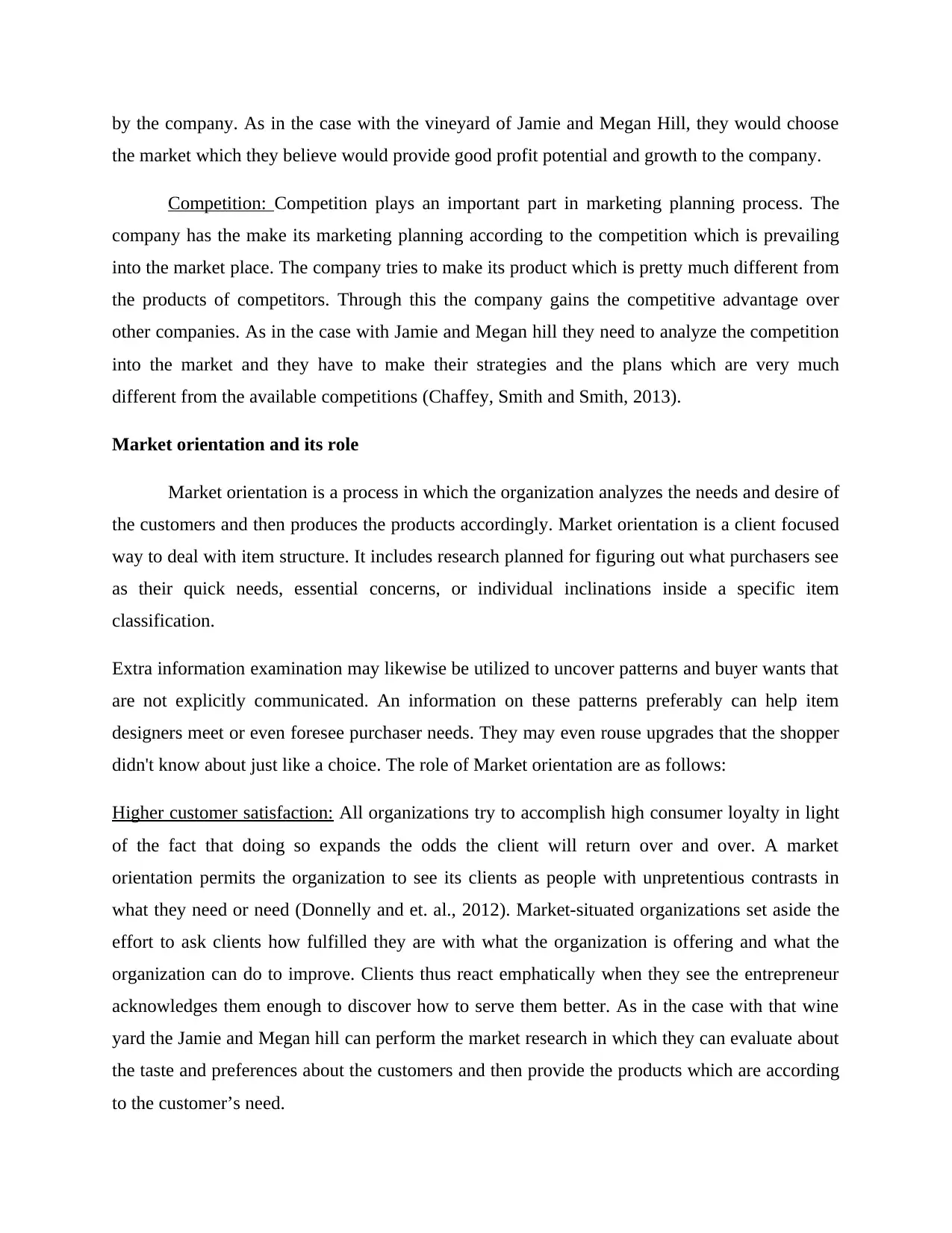
by the company. As in the case with the vineyard of Jamie and Megan Hill, they would choose
the market which they believe would provide good profit potential and growth to the company.
Competition: Competition plays an important part in marketing planning process. The
company has the make its marketing planning according to the competition which is prevailing
into the market place. The company tries to make its product which is pretty much different from
the products of competitors. Through this the company gains the competitive advantage over
other companies. As in the case with Jamie and Megan hill they need to analyze the competition
into the market and they have to make their strategies and the plans which are very much
different from the available competitions (Chaffey, Smith and Smith, 2013).
Market orientation and its role
Market orientation is a process in which the organization analyzes the needs and desire of
the customers and then produces the products accordingly. Market orientation is a client focused
way to deal with item structure. It includes research planned for figuring out what purchasers see
as their quick needs, essential concerns, or individual inclinations inside a specific item
classification.
Extra information examination may likewise be utilized to uncover patterns and buyer wants that
are not explicitly communicated. An information on these patterns preferably can help item
designers meet or even foresee purchaser needs. They may even rouse upgrades that the shopper
didn't know about just like a choice. The role of Market orientation are as follows:
Higher customer satisfaction: All organizations try to accomplish high consumer loyalty in light
of the fact that doing so expands the odds the client will return over and over. A market
orientation permits the organization to see its clients as people with unpretentious contrasts in
what they need or need (Donnelly and et. al., 2012). Market-situated organizations set aside the
effort to ask clients how fulfilled they are with what the organization is offering and what the
organization can do to improve. Clients thus react emphatically when they see the entrepreneur
acknowledges them enough to discover how to serve them better. As in the case with that wine
yard the Jamie and Megan hill can perform the market research in which they can evaluate about
the taste and preferences about the customers and then provide the products which are according
to the customer’s need.
the market which they believe would provide good profit potential and growth to the company.
Competition: Competition plays an important part in marketing planning process. The
company has the make its marketing planning according to the competition which is prevailing
into the market place. The company tries to make its product which is pretty much different from
the products of competitors. Through this the company gains the competitive advantage over
other companies. As in the case with Jamie and Megan hill they need to analyze the competition
into the market and they have to make their strategies and the plans which are very much
different from the available competitions (Chaffey, Smith and Smith, 2013).
Market orientation and its role
Market orientation is a process in which the organization analyzes the needs and desire of
the customers and then produces the products accordingly. Market orientation is a client focused
way to deal with item structure. It includes research planned for figuring out what purchasers see
as their quick needs, essential concerns, or individual inclinations inside a specific item
classification.
Extra information examination may likewise be utilized to uncover patterns and buyer wants that
are not explicitly communicated. An information on these patterns preferably can help item
designers meet or even foresee purchaser needs. They may even rouse upgrades that the shopper
didn't know about just like a choice. The role of Market orientation are as follows:
Higher customer satisfaction: All organizations try to accomplish high consumer loyalty in light
of the fact that doing so expands the odds the client will return over and over. A market
orientation permits the organization to see its clients as people with unpretentious contrasts in
what they need or need (Donnelly and et. al., 2012). Market-situated organizations set aside the
effort to ask clients how fulfilled they are with what the organization is offering and what the
organization can do to improve. Clients thus react emphatically when they see the entrepreneur
acknowledges them enough to discover how to serve them better. As in the case with that wine
yard the Jamie and Megan hill can perform the market research in which they can evaluate about
the taste and preferences about the customers and then provide the products which are according
to the customer’s need.
Paraphrase This Document
Need a fresh take? Get an instant paraphrase of this document with our AI Paraphraser
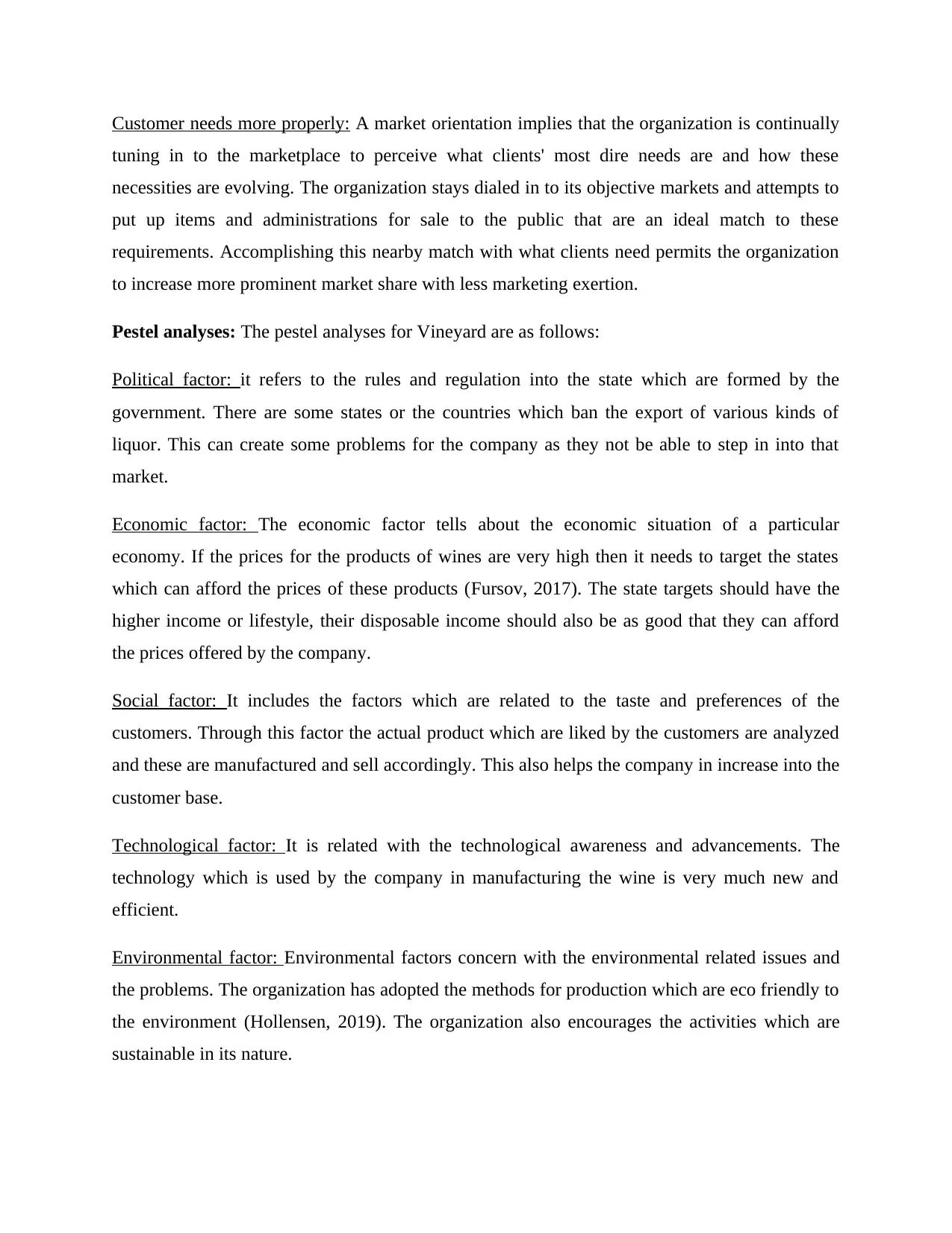
Customer needs more properly: A market orientation implies that the organization is continually
tuning in to the marketplace to perceive what clients' most dire needs are and how these
necessities are evolving. The organization stays dialed in to its objective markets and attempts to
put up items and administrations for sale to the public that are an ideal match to these
requirements. Accomplishing this nearby match with what clients need permits the organization
to increase more prominent market share with less marketing exertion.
Pestel analyses: The pestel analyses for Vineyard are as follows:
Political factor: it refers to the rules and regulation into the state which are formed by the
government. There are some states or the countries which ban the export of various kinds of
liquor. This can create some problems for the company as they not be able to step in into that
market.
Economic factor: The economic factor tells about the economic situation of a particular
economy. If the prices for the products of wines are very high then it needs to target the states
which can afford the prices of these products (Fursov, 2017). The state targets should have the
higher income or lifestyle, their disposable income should also be as good that they can afford
the prices offered by the company.
Social factor: It includes the factors which are related to the taste and preferences of the
customers. Through this factor the actual product which are liked by the customers are analyzed
and these are manufactured and sell accordingly. This also helps the company in increase into the
customer base.
Technological factor: It is related with the technological awareness and advancements. The
technology which is used by the company in manufacturing the wine is very much new and
efficient.
Environmental factor: Environmental factors concern with the environmental related issues and
the problems. The organization has adopted the methods for production which are eco friendly to
the environment (Hollensen, 2019). The organization also encourages the activities which are
sustainable in its nature.
tuning in to the marketplace to perceive what clients' most dire needs are and how these
necessities are evolving. The organization stays dialed in to its objective markets and attempts to
put up items and administrations for sale to the public that are an ideal match to these
requirements. Accomplishing this nearby match with what clients need permits the organization
to increase more prominent market share with less marketing exertion.
Pestel analyses: The pestel analyses for Vineyard are as follows:
Political factor: it refers to the rules and regulation into the state which are formed by the
government. There are some states or the countries which ban the export of various kinds of
liquor. This can create some problems for the company as they not be able to step in into that
market.
Economic factor: The economic factor tells about the economic situation of a particular
economy. If the prices for the products of wines are very high then it needs to target the states
which can afford the prices of these products (Fursov, 2017). The state targets should have the
higher income or lifestyle, their disposable income should also be as good that they can afford
the prices offered by the company.
Social factor: It includes the factors which are related to the taste and preferences of the
customers. Through this factor the actual product which are liked by the customers are analyzed
and these are manufactured and sell accordingly. This also helps the company in increase into the
customer base.
Technological factor: It is related with the technological awareness and advancements. The
technology which is used by the company in manufacturing the wine is very much new and
efficient.
Environmental factor: Environmental factors concern with the environmental related issues and
the problems. The organization has adopted the methods for production which are eco friendly to
the environment (Hollensen, 2019). The organization also encourages the activities which are
sustainable in its nature.
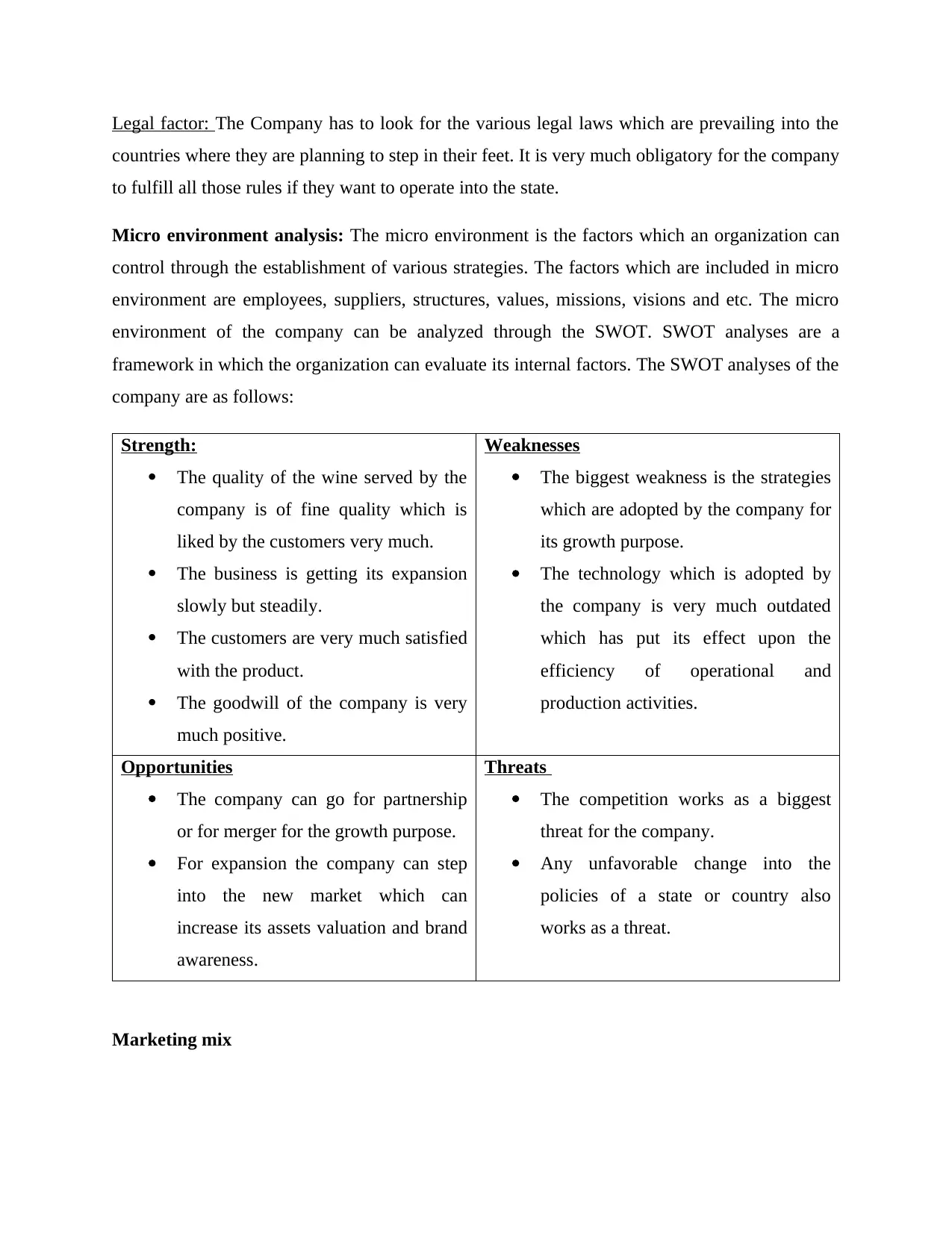
Legal factor: The Company has to look for the various legal laws which are prevailing into the
countries where they are planning to step in their feet. It is very much obligatory for the company
to fulfill all those rules if they want to operate into the state.
Micro environment analysis: The micro environment is the factors which an organization can
control through the establishment of various strategies. The factors which are included in micro
environment are employees, suppliers, structures, values, missions, visions and etc. The micro
environment of the company can be analyzed through the SWOT. SWOT analyses are a
framework in which the organization can evaluate its internal factors. The SWOT analyses of the
company are as follows:
Strength:
The quality of the wine served by the
company is of fine quality which is
liked by the customers very much.
The business is getting its expansion
slowly but steadily.
The customers are very much satisfied
with the product.
The goodwill of the company is very
much positive.
Weaknesses
The biggest weakness is the strategies
which are adopted by the company for
its growth purpose.
The technology which is adopted by
the company is very much outdated
which has put its effect upon the
efficiency of operational and
production activities.
Opportunities
The company can go for partnership
or for merger for the growth purpose.
For expansion the company can step
into the new market which can
increase its assets valuation and brand
awareness.
Threats
The competition works as a biggest
threat for the company.
Any unfavorable change into the
policies of a state or country also
works as a threat.
Marketing mix
countries where they are planning to step in their feet. It is very much obligatory for the company
to fulfill all those rules if they want to operate into the state.
Micro environment analysis: The micro environment is the factors which an organization can
control through the establishment of various strategies. The factors which are included in micro
environment are employees, suppliers, structures, values, missions, visions and etc. The micro
environment of the company can be analyzed through the SWOT. SWOT analyses are a
framework in which the organization can evaluate its internal factors. The SWOT analyses of the
company are as follows:
Strength:
The quality of the wine served by the
company is of fine quality which is
liked by the customers very much.
The business is getting its expansion
slowly but steadily.
The customers are very much satisfied
with the product.
The goodwill of the company is very
much positive.
Weaknesses
The biggest weakness is the strategies
which are adopted by the company for
its growth purpose.
The technology which is adopted by
the company is very much outdated
which has put its effect upon the
efficiency of operational and
production activities.
Opportunities
The company can go for partnership
or for merger for the growth purpose.
For expansion the company can step
into the new market which can
increase its assets valuation and brand
awareness.
Threats
The competition works as a biggest
threat for the company.
Any unfavorable change into the
policies of a state or country also
works as a threat.
Marketing mix
⊘ This is a preview!⊘
Do you want full access?
Subscribe today to unlock all pages.

Trusted by 1+ million students worldwide
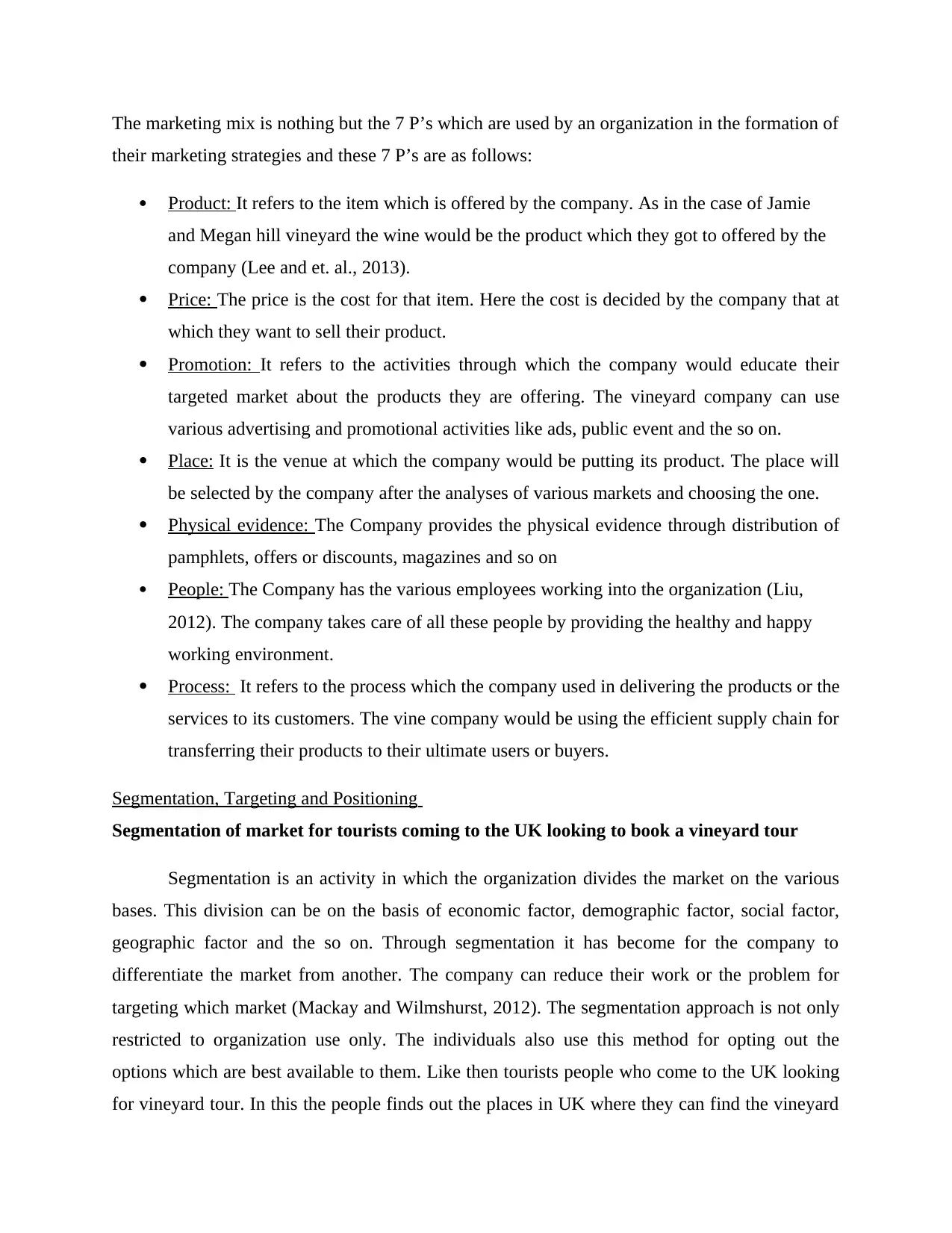
The marketing mix is nothing but the 7 P’s which are used by an organization in the formation of
their marketing strategies and these 7 P’s are as follows:
Product: It refers to the item which is offered by the company. As in the case of Jamie
and Megan hill vineyard the wine would be the product which they got to offered by the
company (Lee and et. al., 2013).
Price: The price is the cost for that item. Here the cost is decided by the company that at
which they want to sell their product.
Promotion: It refers to the activities through which the company would educate their
targeted market about the products they are offering. The vineyard company can use
various advertising and promotional activities like ads, public event and the so on.
Place: It is the venue at which the company would be putting its product. The place will
be selected by the company after the analyses of various markets and choosing the one.
Physical evidence: The Company provides the physical evidence through distribution of
pamphlets, offers or discounts, magazines and so on
People: The Company has the various employees working into the organization (Liu,
2012). The company takes care of all these people by providing the healthy and happy
working environment.
Process: It refers to the process which the company used in delivering the products or the
services to its customers. The vine company would be using the efficient supply chain for
transferring their products to their ultimate users or buyers.
Segmentation, Targeting and Positioning
Segmentation of market for tourists coming to the UK looking to book a vineyard tour
Segmentation is an activity in which the organization divides the market on the various
bases. This division can be on the basis of economic factor, demographic factor, social factor,
geographic factor and the so on. Through segmentation it has become for the company to
differentiate the market from another. The company can reduce their work or the problem for
targeting which market (Mackay and Wilmshurst, 2012). The segmentation approach is not only
restricted to organization use only. The individuals also use this method for opting out the
options which are best available to them. Like then tourists people who come to the UK looking
for vineyard tour. In this the people finds out the places in UK where they can find the vineyard
their marketing strategies and these 7 P’s are as follows:
Product: It refers to the item which is offered by the company. As in the case of Jamie
and Megan hill vineyard the wine would be the product which they got to offered by the
company (Lee and et. al., 2013).
Price: The price is the cost for that item. Here the cost is decided by the company that at
which they want to sell their product.
Promotion: It refers to the activities through which the company would educate their
targeted market about the products they are offering. The vineyard company can use
various advertising and promotional activities like ads, public event and the so on.
Place: It is the venue at which the company would be putting its product. The place will
be selected by the company after the analyses of various markets and choosing the one.
Physical evidence: The Company provides the physical evidence through distribution of
pamphlets, offers or discounts, magazines and so on
People: The Company has the various employees working into the organization (Liu,
2012). The company takes care of all these people by providing the healthy and happy
working environment.
Process: It refers to the process which the company used in delivering the products or the
services to its customers. The vine company would be using the efficient supply chain for
transferring their products to their ultimate users or buyers.
Segmentation, Targeting and Positioning
Segmentation of market for tourists coming to the UK looking to book a vineyard tour
Segmentation is an activity in which the organization divides the market on the various
bases. This division can be on the basis of economic factor, demographic factor, social factor,
geographic factor and the so on. Through segmentation it has become for the company to
differentiate the market from another. The company can reduce their work or the problem for
targeting which market (Mackay and Wilmshurst, 2012). The segmentation approach is not only
restricted to organization use only. The individuals also use this method for opting out the
options which are best available to them. Like then tourists people who come to the UK looking
for vineyard tour. In this the people finds out the places in UK where they can find the vineyard
Paraphrase This Document
Need a fresh take? Get an instant paraphrase of this document with our AI Paraphraser
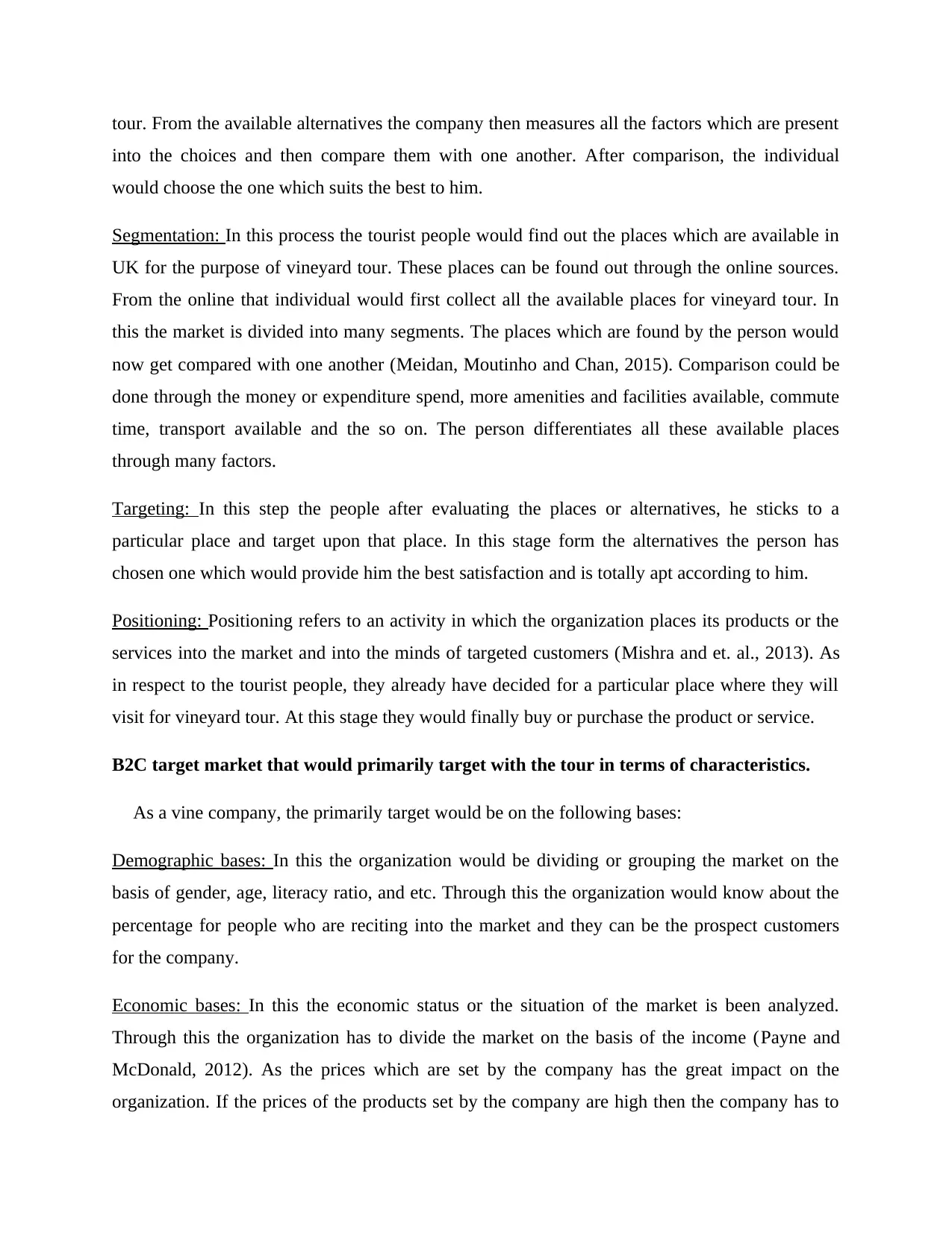
tour. From the available alternatives the company then measures all the factors which are present
into the choices and then compare them with one another. After comparison, the individual
would choose the one which suits the best to him.
Segmentation: In this process the tourist people would find out the places which are available in
UK for the purpose of vineyard tour. These places can be found out through the online sources.
From the online that individual would first collect all the available places for vineyard tour. In
this the market is divided into many segments. The places which are found by the person would
now get compared with one another (Meidan, Moutinho and Chan, 2015). Comparison could be
done through the money or expenditure spend, more amenities and facilities available, commute
time, transport available and the so on. The person differentiates all these available places
through many factors.
Targeting: In this step the people after evaluating the places or alternatives, he sticks to a
particular place and target upon that place. In this stage form the alternatives the person has
chosen one which would provide him the best satisfaction and is totally apt according to him.
Positioning: Positioning refers to an activity in which the organization places its products or the
services into the market and into the minds of targeted customers (Mishra and et. al., 2013). As
in respect to the tourist people, they already have decided for a particular place where they will
visit for vineyard tour. At this stage they would finally buy or purchase the product or service.
B2C target market that would primarily target with the tour in terms of characteristics.
As a vine company, the primarily target would be on the following bases:
Demographic bases: In this the organization would be dividing or grouping the market on the
basis of gender, age, literacy ratio, and etc. Through this the organization would know about the
percentage for people who are reciting into the market and they can be the prospect customers
for the company.
Economic bases: In this the economic status or the situation of the market is been analyzed.
Through this the organization has to divide the market on the basis of the income (Payne and
McDonald, 2012). As the prices which are set by the company has the great impact on the
organization. If the prices of the products set by the company are high then the company has to
into the choices and then compare them with one another. After comparison, the individual
would choose the one which suits the best to him.
Segmentation: In this process the tourist people would find out the places which are available in
UK for the purpose of vineyard tour. These places can be found out through the online sources.
From the online that individual would first collect all the available places for vineyard tour. In
this the market is divided into many segments. The places which are found by the person would
now get compared with one another (Meidan, Moutinho and Chan, 2015). Comparison could be
done through the money or expenditure spend, more amenities and facilities available, commute
time, transport available and the so on. The person differentiates all these available places
through many factors.
Targeting: In this step the people after evaluating the places or alternatives, he sticks to a
particular place and target upon that place. In this stage form the alternatives the person has
chosen one which would provide him the best satisfaction and is totally apt according to him.
Positioning: Positioning refers to an activity in which the organization places its products or the
services into the market and into the minds of targeted customers (Mishra and et. al., 2013). As
in respect to the tourist people, they already have decided for a particular place where they will
visit for vineyard tour. At this stage they would finally buy or purchase the product or service.
B2C target market that would primarily target with the tour in terms of characteristics.
As a vine company, the primarily target would be on the following bases:
Demographic bases: In this the organization would be dividing or grouping the market on the
basis of gender, age, literacy ratio, and etc. Through this the organization would know about the
percentage for people who are reciting into the market and they can be the prospect customers
for the company.
Economic bases: In this the economic status or the situation of the market is been analyzed.
Through this the organization has to divide the market on the basis of the income (Payne and
McDonald, 2012). As the prices which are set by the company has the great impact on the
organization. If the prices of the products set by the company are high then the company has to
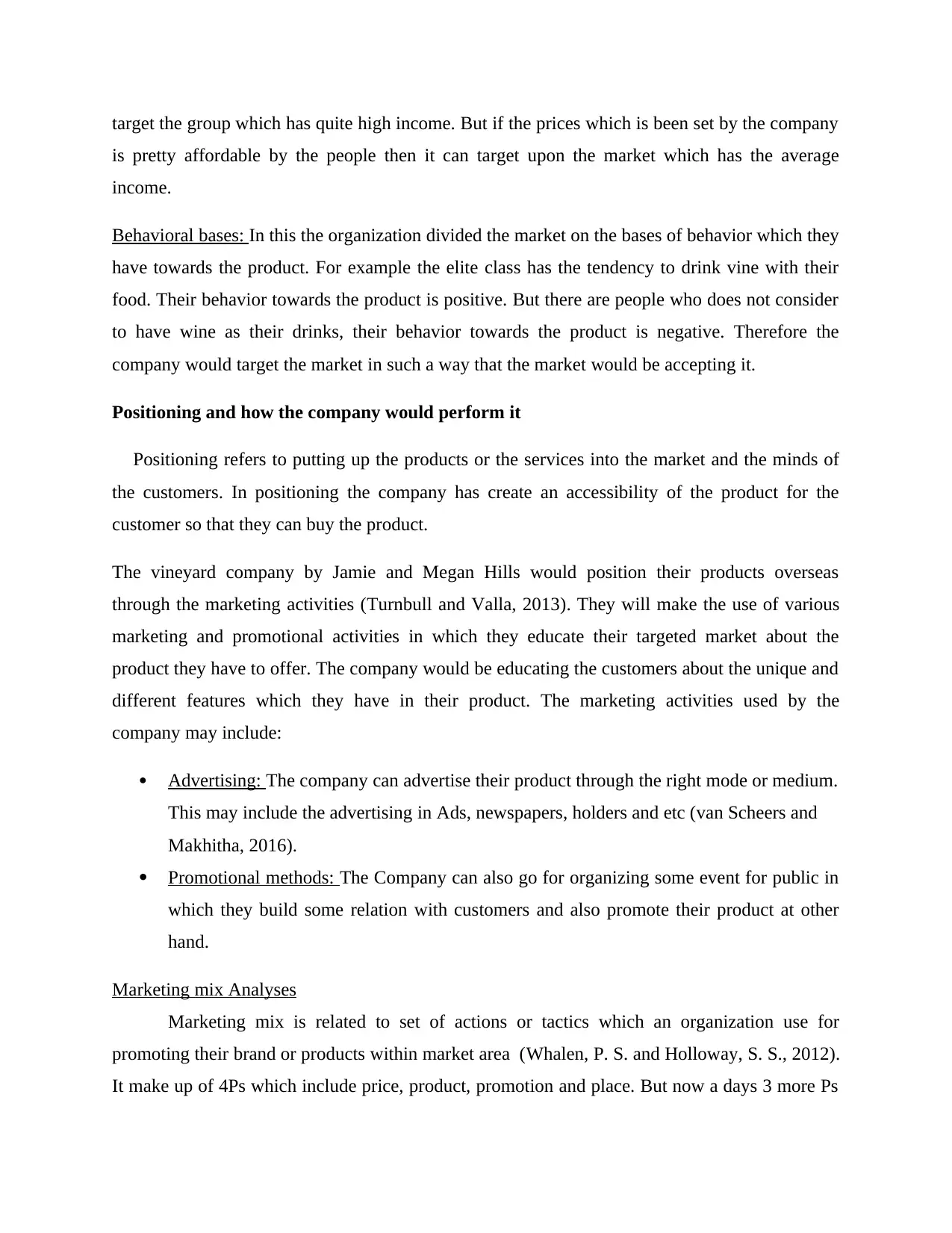
target the group which has quite high income. But if the prices which is been set by the company
is pretty affordable by the people then it can target upon the market which has the average
income.
Behavioral bases: In this the organization divided the market on the bases of behavior which they
have towards the product. For example the elite class has the tendency to drink vine with their
food. Their behavior towards the product is positive. But there are people who does not consider
to have wine as their drinks, their behavior towards the product is negative. Therefore the
company would target the market in such a way that the market would be accepting it.
Positioning and how the company would perform it
Positioning refers to putting up the products or the services into the market and the minds of
the customers. In positioning the company has create an accessibility of the product for the
customer so that they can buy the product.
The vineyard company by Jamie and Megan Hills would position their products overseas
through the marketing activities (Turnbull and Valla, 2013). They will make the use of various
marketing and promotional activities in which they educate their targeted market about the
product they have to offer. The company would be educating the customers about the unique and
different features which they have in their product. The marketing activities used by the
company may include:
Advertising: The company can advertise their product through the right mode or medium.
This may include the advertising in Ads, newspapers, holders and etc (van Scheers and
Makhitha, 2016).
Promotional methods: The Company can also go for organizing some event for public in
which they build some relation with customers and also promote their product at other
hand.
Marketing mix Analyses
Marketing mix is related to set of actions or tactics which an organization use for
promoting their brand or products within market area (Whalen, P. S. and Holloway, S. S., 2012).
It make up of 4Ps which include price, product, promotion and place. But now a days 3 more Ps
is pretty affordable by the people then it can target upon the market which has the average
income.
Behavioral bases: In this the organization divided the market on the bases of behavior which they
have towards the product. For example the elite class has the tendency to drink vine with their
food. Their behavior towards the product is positive. But there are people who does not consider
to have wine as their drinks, their behavior towards the product is negative. Therefore the
company would target the market in such a way that the market would be accepting it.
Positioning and how the company would perform it
Positioning refers to putting up the products or the services into the market and the minds of
the customers. In positioning the company has create an accessibility of the product for the
customer so that they can buy the product.
The vineyard company by Jamie and Megan Hills would position their products overseas
through the marketing activities (Turnbull and Valla, 2013). They will make the use of various
marketing and promotional activities in which they educate their targeted market about the
product they have to offer. The company would be educating the customers about the unique and
different features which they have in their product. The marketing activities used by the
company may include:
Advertising: The company can advertise their product through the right mode or medium.
This may include the advertising in Ads, newspapers, holders and etc (van Scheers and
Makhitha, 2016).
Promotional methods: The Company can also go for organizing some event for public in
which they build some relation with customers and also promote their product at other
hand.
Marketing mix Analyses
Marketing mix is related to set of actions or tactics which an organization use for
promoting their brand or products within market area (Whalen, P. S. and Holloway, S. S., 2012).
It make up of 4Ps which include price, product, promotion and place. But now a days 3 more Ps
⊘ This is a preview!⊘
Do you want full access?
Subscribe today to unlock all pages.

Trusted by 1+ million students worldwide
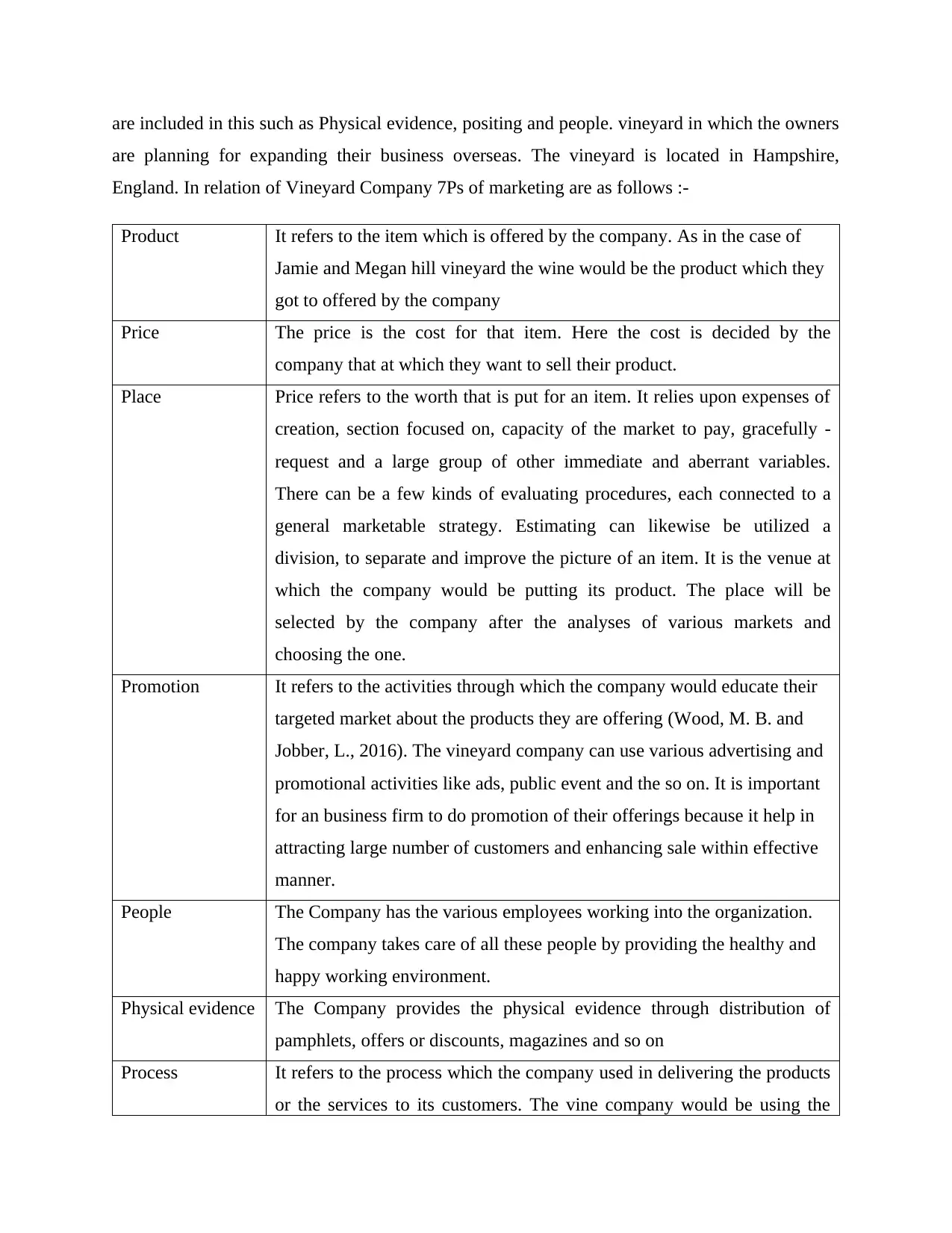
are included in this such as Physical evidence, positing and people. vineyard in which the owners
are planning for expanding their business overseas. The vineyard is located in Hampshire,
England. In relation of Vineyard Company 7Ps of marketing are as follows :-
Product It refers to the item which is offered by the company. As in the case of
Jamie and Megan hill vineyard the wine would be the product which they
got to offered by the company
Price The price is the cost for that item. Here the cost is decided by the
company that at which they want to sell their product.
Place Price refers to the worth that is put for an item. It relies upon expenses of
creation, section focused on, capacity of the market to pay, gracefully -
request and a large group of other immediate and aberrant variables.
There can be a few kinds of evaluating procedures, each connected to a
general marketable strategy. Estimating can likewise be utilized a
division, to separate and improve the picture of an item. It is the venue at
which the company would be putting its product. The place will be
selected by the company after the analyses of various markets and
choosing the one.
Promotion It refers to the activities through which the company would educate their
targeted market about the products they are offering (Wood, M. B. and
Jobber, L., 2016). The vineyard company can use various advertising and
promotional activities like ads, public event and the so on. It is important
for an business firm to do promotion of their offerings because it help in
attracting large number of customers and enhancing sale within effective
manner.
People The Company has the various employees working into the organization.
The company takes care of all these people by providing the healthy and
happy working environment.
Physical evidence The Company provides the physical evidence through distribution of
pamphlets, offers or discounts, magazines and so on
Process It refers to the process which the company used in delivering the products
or the services to its customers. The vine company would be using the
are planning for expanding their business overseas. The vineyard is located in Hampshire,
England. In relation of Vineyard Company 7Ps of marketing are as follows :-
Product It refers to the item which is offered by the company. As in the case of
Jamie and Megan hill vineyard the wine would be the product which they
got to offered by the company
Price The price is the cost for that item. Here the cost is decided by the
company that at which they want to sell their product.
Place Price refers to the worth that is put for an item. It relies upon expenses of
creation, section focused on, capacity of the market to pay, gracefully -
request and a large group of other immediate and aberrant variables.
There can be a few kinds of evaluating procedures, each connected to a
general marketable strategy. Estimating can likewise be utilized a
division, to separate and improve the picture of an item. It is the venue at
which the company would be putting its product. The place will be
selected by the company after the analyses of various markets and
choosing the one.
Promotion It refers to the activities through which the company would educate their
targeted market about the products they are offering (Wood, M. B. and
Jobber, L., 2016). The vineyard company can use various advertising and
promotional activities like ads, public event and the so on. It is important
for an business firm to do promotion of their offerings because it help in
attracting large number of customers and enhancing sale within effective
manner.
People The Company has the various employees working into the organization.
The company takes care of all these people by providing the healthy and
happy working environment.
Physical evidence The Company provides the physical evidence through distribution of
pamphlets, offers or discounts, magazines and so on
Process It refers to the process which the company used in delivering the products
or the services to its customers. The vine company would be using the
Paraphrase This Document
Need a fresh take? Get an instant paraphrase of this document with our AI Paraphraser
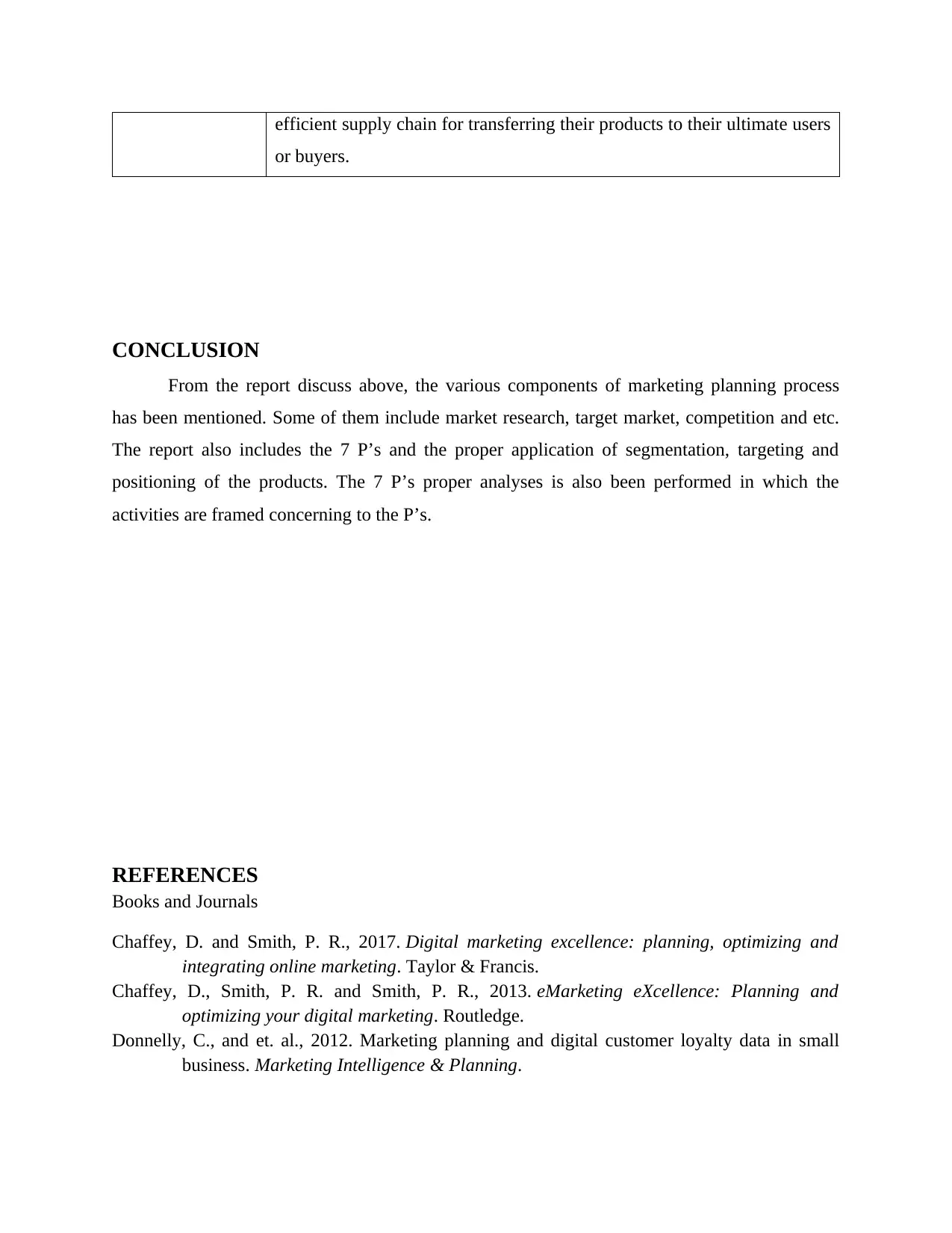
efficient supply chain for transferring their products to their ultimate users
or buyers.
CONCLUSION
From the report discuss above, the various components of marketing planning process
has been mentioned. Some of them include market research, target market, competition and etc.
The report also includes the 7 P’s and the proper application of segmentation, targeting and
positioning of the products. The 7 P’s proper analyses is also been performed in which the
activities are framed concerning to the P’s.
REFERENCES
Books and Journals
Chaffey, D. and Smith, P. R., 2017. Digital marketing excellence: planning, optimizing and
integrating online marketing. Taylor & Francis.
Chaffey, D., Smith, P. R. and Smith, P. R., 2013. eMarketing eXcellence: Planning and
optimizing your digital marketing. Routledge.
Donnelly, C., and et. al., 2012. Marketing planning and digital customer loyalty data in small
business. Marketing Intelligence & Planning.
or buyers.
CONCLUSION
From the report discuss above, the various components of marketing planning process
has been mentioned. Some of them include market research, target market, competition and etc.
The report also includes the 7 P’s and the proper application of segmentation, targeting and
positioning of the products. The 7 P’s proper analyses is also been performed in which the
activities are framed concerning to the P’s.
REFERENCES
Books and Journals
Chaffey, D. and Smith, P. R., 2017. Digital marketing excellence: planning, optimizing and
integrating online marketing. Taylor & Francis.
Chaffey, D., Smith, P. R. and Smith, P. R., 2013. eMarketing eXcellence: Planning and
optimizing your digital marketing. Routledge.
Donnelly, C., and et. al., 2012. Marketing planning and digital customer loyalty data in small
business. Marketing Intelligence & Planning.
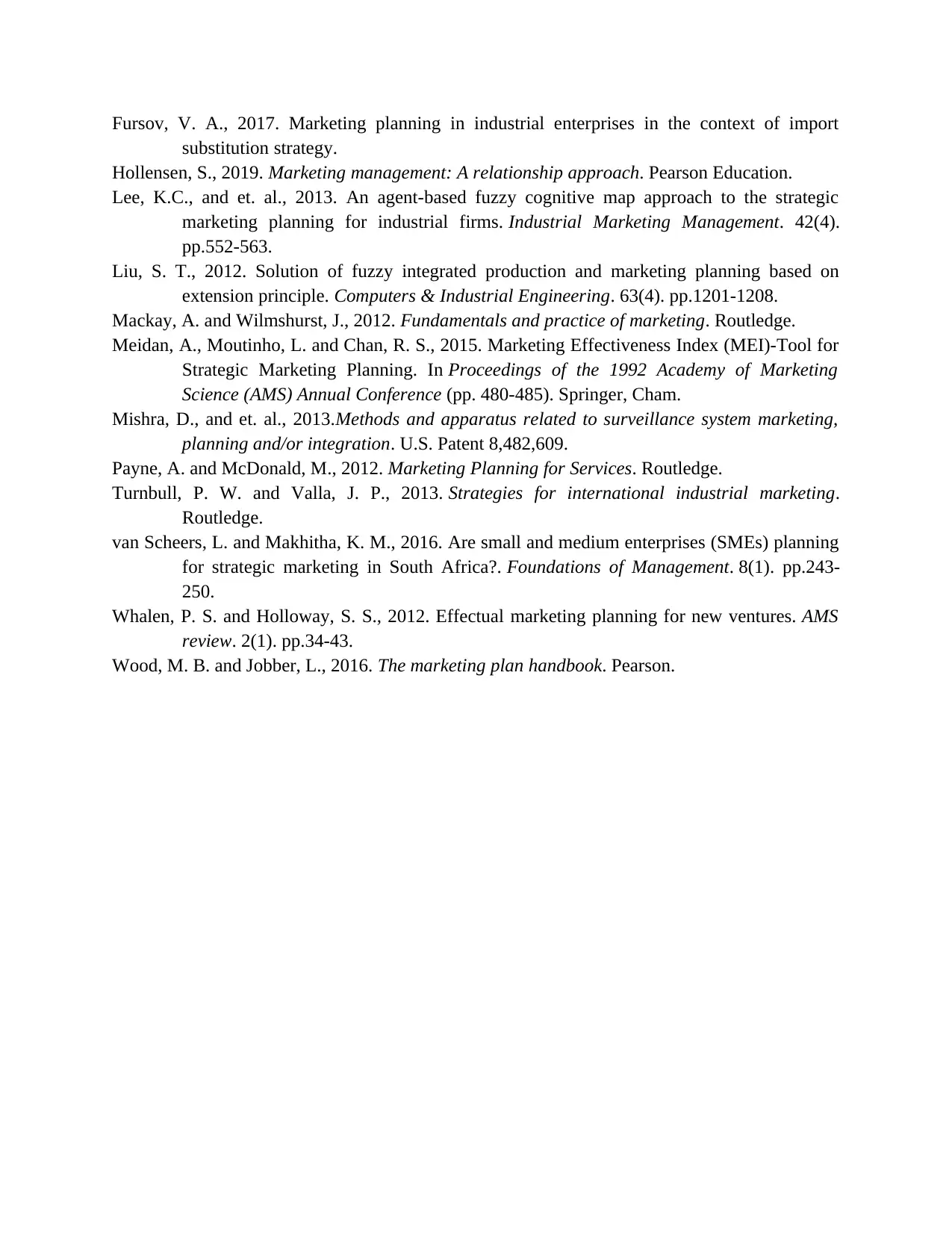
Fursov, V. A., 2017. Marketing planning in industrial enterprises in the context of import
substitution strategy.
Hollensen, S., 2019. Marketing management: A relationship approach. Pearson Education.
Lee, K.C., and et. al., 2013. An agent-based fuzzy cognitive map approach to the strategic
marketing planning for industrial firms. Industrial Marketing Management. 42(4).
pp.552-563.
Liu, S. T., 2012. Solution of fuzzy integrated production and marketing planning based on
extension principle. Computers & Industrial Engineering. 63(4). pp.1201-1208.
Mackay, A. and Wilmshurst, J., 2012. Fundamentals and practice of marketing. Routledge.
Meidan, A., Moutinho, L. and Chan, R. S., 2015. Marketing Effectiveness Index (MEI)-Tool for
Strategic Marketing Planning. In Proceedings of the 1992 Academy of Marketing
Science (AMS) Annual Conference (pp. 480-485). Springer, Cham.
Mishra, D., and et. al., 2013.Methods and apparatus related to surveillance system marketing,
planning and/or integration. U.S. Patent 8,482,609.
Payne, A. and McDonald, M., 2012. Marketing Planning for Services. Routledge.
Turnbull, P. W. and Valla, J. P., 2013. Strategies for international industrial marketing.
Routledge.
van Scheers, L. and Makhitha, K. M., 2016. Are small and medium enterprises (SMEs) planning
for strategic marketing in South Africa?. Foundations of Management. 8(1). pp.243-
250.
Whalen, P. S. and Holloway, S. S., 2012. Effectual marketing planning for new ventures. AMS
review. 2(1). pp.34-43.
Wood, M. B. and Jobber, L., 2016. The marketing plan handbook. Pearson.
substitution strategy.
Hollensen, S., 2019. Marketing management: A relationship approach. Pearson Education.
Lee, K.C., and et. al., 2013. An agent-based fuzzy cognitive map approach to the strategic
marketing planning for industrial firms. Industrial Marketing Management. 42(4).
pp.552-563.
Liu, S. T., 2012. Solution of fuzzy integrated production and marketing planning based on
extension principle. Computers & Industrial Engineering. 63(4). pp.1201-1208.
Mackay, A. and Wilmshurst, J., 2012. Fundamentals and practice of marketing. Routledge.
Meidan, A., Moutinho, L. and Chan, R. S., 2015. Marketing Effectiveness Index (MEI)-Tool for
Strategic Marketing Planning. In Proceedings of the 1992 Academy of Marketing
Science (AMS) Annual Conference (pp. 480-485). Springer, Cham.
Mishra, D., and et. al., 2013.Methods and apparatus related to surveillance system marketing,
planning and/or integration. U.S. Patent 8,482,609.
Payne, A. and McDonald, M., 2012. Marketing Planning for Services. Routledge.
Turnbull, P. W. and Valla, J. P., 2013. Strategies for international industrial marketing.
Routledge.
van Scheers, L. and Makhitha, K. M., 2016. Are small and medium enterprises (SMEs) planning
for strategic marketing in South Africa?. Foundations of Management. 8(1). pp.243-
250.
Whalen, P. S. and Holloway, S. S., 2012. Effectual marketing planning for new ventures. AMS
review. 2(1). pp.34-43.
Wood, M. B. and Jobber, L., 2016. The marketing plan handbook. Pearson.
⊘ This is a preview!⊘
Do you want full access?
Subscribe today to unlock all pages.

Trusted by 1+ million students worldwide
1 out of 12
Related Documents
Your All-in-One AI-Powered Toolkit for Academic Success.
+13062052269
info@desklib.com
Available 24*7 on WhatsApp / Email
![[object Object]](/_next/static/media/star-bottom.7253800d.svg)
Unlock your academic potential
Copyright © 2020–2025 A2Z Services. All Rights Reserved. Developed and managed by ZUCOL.





